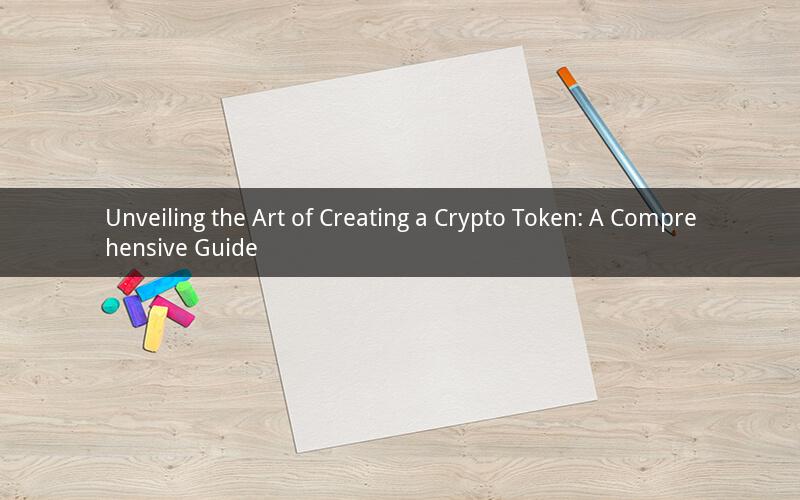
Creating a crypto token is a multifaceted process that involves technical knowledge, strategic planning, and a thorough understanding of the blockchain ecosystem. Whether you are looking to launch a new cryptocurrency or simply want to explore the world of tokenomics, this guide will walk you through the essential steps and considerations for creating a crypto token.
Understanding Crypto Tokens
Before diving into the creation process, it is crucial to have a clear understanding of what a crypto token is. A crypto token is a digital asset that is built on top of a blockchain network, typically representing a unit of value or a specific utility within a decentralized application (dApp) or a cryptocurrency platform. Tokens can be categorized into several types, such as utility tokens, security tokens, and equity tokens, each serving different purposes and regulations.
Selecting a Blockchain Platform
The first step in creating a crypto token is to choose a blockchain platform on which the token will be built. There are several popular platforms, such as Ethereum, Binance Smart Chain, and Cardano, each with its unique features and benefits. When selecting a platform, consider factors such as transaction speed, scalability, gas fees, and the availability of development tools.
Designing the Tokenomics
Tokenomics refers to the economic model that governs the distribution, supply, and demand of a crypto token. Designing an effective tokenomics model is crucial for ensuring the long-term success and sustainability of your token. Some key aspects to consider when designing your tokenomics include:
1. Total supply: Determine the maximum number of tokens that will ever be created.
2. Initial distribution: Decide how many tokens will be allocated to different stakeholders, such as investors, team members, and advisors.
3. Token burning: Implement a mechanism for burning tokens to reduce the supply and increase the value of the remaining tokens.
4. Inflation and deflation: Consider how the token's supply will change over time, either through inflation (increased supply) or deflation (reduced supply).
5. Token utility: Define the purpose of the token within your project and how it will be used within the ecosystem.
Developing the Smart Contract
The smart contract is a self-executing contract with the terms of the agreement directly written into code. In the context of a crypto token, the smart contract will manage the token supply, distribution, and any other features you want to include. Here are the key steps in developing a smart contract:
1. Choose a programming language: Solidity is the most popular language for writing smart contracts on Ethereum, while other platforms may have their own languages, such as NEAR's NEAR.
2. Outline the contract structure: Define the functions, variables, and data structures required for your token.
3. Write the contract code: Implement the logic for your token's tokenomics and any other features you want to include.
4. Test the contract: Use a test network to verify that your contract functions correctly and does not have any vulnerabilities.
5. Deploy the contract: Once your contract is tested and verified, deploy it to the main blockchain network.
Marketing and Launching the Token
Marketing and launching your crypto token are critical steps in attracting users and investors. Here are some strategies to help you succeed:
1. Develop a whitepaper: A comprehensive whitepaper outlines your project's goals, technology, tokenomics, and roadmap. Share it with potential investors and developers.
2. Build a community: Engage with potential users and investors on social media platforms, forums, and online communities. Attend conferences and webinars to increase your project's visibility.
3. Create a roadmap: A roadmap provides a timeline for your project's development, milestones, and upcoming features. This will help build trust with your community and investors.
4. Partner with influencers and exchanges: Collaborate with influencers, bloggers, and crypto exchanges to promote your token and increase its visibility.
5. Launch a token sale or airdrop: Offer incentives to early adopters by conducting a token sale or airdrop, which can help create demand for your token.
Frequently Asked Questions
1. Q: Can I create a crypto token without any technical knowledge?
A: Yes, you can create a crypto token using platforms like Binance Smart Chain, which offer user-friendly interfaces and tools for non-technical users.
2. Q: What are the main differences between a utility token and a security token?
A: Utility tokens are used within a specific application or platform, while security tokens represent ownership or investment in a company. Security tokens are subject to regulatory compliance, whereas utility tokens are not.
3. Q: How do I ensure the security of my crypto token's smart contract?
A: To ensure the security of your smart contract, thoroughly test it on test networks, conduct audits by reputable firms, and follow best practices for smart contract development.
4. Q: Can I create a crypto token on multiple blockchain platforms?
A: Yes, you can create a token on multiple blockchain platforms, but it may require additional development and maintenance efforts to ensure compatibility and functionality across different networks.
5. Q: What are the potential risks associated with creating a crypto token?
A: The main risks include regulatory compliance issues, smart contract vulnerabilities, market competition, and the overall volatility of the cryptocurrency market. Conduct thorough research and consult with legal and financial experts to mitigate these risks.